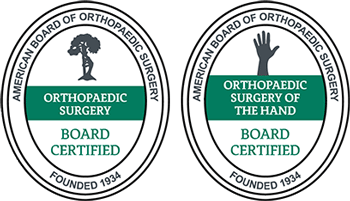How to Tell You Sprained Your Hand
Strains and sprains account for around 12.3% of all hand and wrist injuries seen in the emergency room. These injuries are more common among athletes, but you can sprain your wrist or hand with something as simple as a fall. If you suspect that you’ve suffered from a serious hand sprain, it’s important to see a doctor so you can get the proper treatment for this injury and fully regain your strength and range of motion as you recover.
Contents
Understanding Hand Sprains: Causes and Differences

persons left hand with gold ring by ølı is licensed with Unsplash License
A hand sprain occurs when one of the four ligaments in the hand is stretched or torn. The proximal interphalangeal joints in the middle of your fingers are the most likely victims of a hand sprain. The metacarpophalangeal joint in the thumb can also suffer from a sprain, particularly if you fall in a way that pulls the thumb away from the hand.
Hand sprains typically occur when you suffer a sharp impact to the wrist or break your fall with your hand. Sports such as basketball, baseball, gymnastics, skiing, skating, and skateboarding often result in hand sprains. If you’ve sprained your hand once, there’s a greater likelihood you’ll sprain it again.
Hand Sprains vs. Strains
Hand strains are often confused with hand and wrist sprains, but a strain is a different type of injury. A strain occurs when the muscle or tendon fibers are stretched or torn. Strains usually impact the tendons that connect the forearm muscles to the finger bones. Hand strains are common in sports that require a lot of gripping, such as golf, tennis, rowing, or gymnastics.
Hand strains and sprains have similar symptoms. Muscle cramping is more common with a strain rather than a sprain, but it can be difficult to pinpoint the exact source of your pain when you’re suffering from a hand injury. You may not know which type of injury you have without a professional diagnosis.
Recognizing Symptoms of a Sprained Hand
You’ll usually notice the moment you sprain your hand. This type of injury can result from a fall on an outstretched hand, twisting or hyperextending your hand or forearm, or any other forceful movement or impact.
Physical Symptoms
Following a hand sprain, you’ll usually notice:
- Pain or discomfort
- Stiffness
- Swelling and warmth
- Bruising
- Limited range of motion
- Popping in the hand or wrist
Grading Severity: Mild, Moderate, and Severe Symptoms
Wrist sprains are classified by degree, with each subsequent rating indicating a worse injury. Your symptoms will help you evaluate the degree of your injury. You should see a doctor for a professional diagnosis if you suspect a second- or third-degree sprain.
- First degree: Bruising, mild pain, and moderately impacted mobility from a stretched ligament
- Second degree: Swelling, weakness, prolonged pain, and limited range of motion from a partially torn ligament
- Third degree: Bruising, swelling, severe pain, limited range of motion, and difficulty using the wrist due to a complete tear of the ligament
A third-degree sprain always requires medical attention. When the ligament suffers from this type of complete tear, it often pulls some of the bone away with it, which is known as an avulsion fracture. Avulsion fractures often require surgical intervention to heal properly.
A second-degree sprain may require medical attention. As second-degree sprains can compromise your wrist stability, you should avoid any sports that rely on the injured hand until it has healed sufficiently.
First-degree sprains will often heal on their own. You can still use your wrist, though you should rest it when you can to help the injury heal faster.
Identifying Complications of Untreated Sprains
If a severe hand sprain isn’t treated correctly, you can suffer from long-term complications. If the ligament doesn’t heal properly, you may have a limited range of motion, making fine motor skills more difficult. You may struggle to write, type, or button a shirt if your ligaments are compromised. Chronic hand pain, such as a dull ache, prolonged throbbing, or sharp stabbing sensation, may also result from an untreated sprain.
If you have an untreated fracture along with your hand sprain, you may suffer from malunion. Malunion occurs when the bones don’t fuse properly, which may leave you with ongoing numbness, weakness, or deformity in your hand.
Diagnosing a Sprained Hand: Tests and Procedures
Hand sprain diagnosis begins with a physical examination and consideration of the symptoms. If your injury is consistent with a sprain, your doctor will typically order imaging tests to confirm the diagnosis and evaluate the location and severity of the sprain. These may include an X-ray, ultrasound, CT scan, MRI, or any combination of the four.
Treatment and Recovery for a Sprained Hand
Immediately following a suspected hand sprain, you should implement the RICE method:
- Rest the hand.
- Ice the injury for 15 to 20 minutes at a time over the first 48 to 72 hours.
- Wear a compression glove or wrap.
- Elevate the hand above the heart when resting to minimize swelling.
If the discomfort doesn’t lessen or resolve within a few days, you should see a doctor. It’s also important to see a doctor if the pain is focused around bony structures in the hand, as this could indicate a fracture. Fractures require immediate attention so they can be set properly.
Contact Dr. Knight at The Hand and Wrist Institute
If you suspect that you’ve suffered a hand or wrist sprain, contact our team at The Hand and Wrist Institute. Dr. Knight is a highly trained wrist specialist and orthopedic surgeon, equipped to handle any hand or wrist injury. We can carefully evaluate your sprain and offer a personalized treatment plan to help you recover fully and get back to pain-free functionality. Contact us to learn more or to schedule your appointment.

























